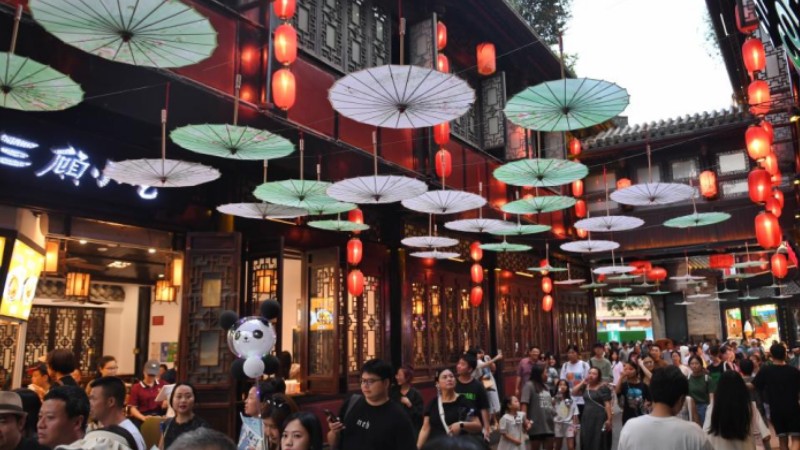Explainer: Why won't China become the next Japan?
BEIJING, July 19 (Xinhua) -- There has been a lot of hype recently across some Western media outlets over whether China is entering a "balance sheet recession," which -- according to some -- could drag China into a Japan-style "lost decade."
Such argument fails to recognize the key differences between China's current economy and Japan's economy in the 1990s, and many economists have pointed out that China, with its economic resilience and sound policies, will not repeat Japan's missteps.
"BALANCE SHEET RECESSION"
Since the beginning of this year, the Chinese economy has continued to recover, with a strong start in Q1 and continued momentum in Q2.
Amid a grave and complex international environment, and with the tasks of reform remaining arduous, the country still faces multiple economic challenges such as falling asset prices, the downturn in the stock and real estate markets, the decline in household assets growth, and the reduction of investment and consumption by companies and households.
Such challenges have given rise to the discussion over the Chinese economic outlook, as some economists and observers claim that China has fallen, or is falling, or could fall into a "balance sheet recession," just as Japan did.
Richard Koo, chief economist at Nomura Research Institute, recently argued that China is entering a balance sheet recession, noting that Chinese companies and households are borrowing less.
Reflecting on the Japanese economy after the bubble burst, Koo coined the term "balance sheet recession," defining it as a situation in which consumers and businesses tend to put more money toward paying down debt instead of spending or investing.
The theory argues that recessions usually follow the collapse of asset-price bubbles. Companies borrowed to buy a lot of assets during the asset-price boom. Once the bubbles burst, the value of the liability side of the balance sheet remains unchanged, but the value of the asset side plummets, making these companies insolvent.
Meanwhile, there is no problem in the production and operation of these companies. The goal of these companies is then changed from "profit maximization" to "debt minimization," leading to a situation in which banks are unable to find borrowers.
As a result, businesses and consumers spend most of their income on debt repayment, and reduce investment and consumption, credit demand stagnates or decreases, monetary policy becomes ineffective, and economic activity shrinks.
Not only is there strong evidence that this phenomenon was responsible for Japan's post-bubble stagnation and deflation, signs of such a slump were also apparent in the euro zone and the United States following the 2008 financial crash, Nicholas Spiro, a partner at London-based Lauressa Advisory, said in an opinion piece in South China Morning Post.
LESSONS FROM JAPAN'S "LOST DECADE"
Japan's "balance sheet recession" after the bursting of its real estate bubble in 1990 was due to its policy flip-flops, which caused the recession to persist, despite strong monetary and fiscal stimuli.
After the Plaza Accord was signed in 1985, the yen appreciated sharply against the U.S. dollar and Japanese exporters were hit hard. To reverse the economic downturn, the Bank of Japan kept cutting interest rates, injecting massive liquidity into the stock and real estate markets, inflating asset bubbles. At its peak, the average land price in Japan rose by more than 60 percent compared with that before the signing of the Plaza Accord, and commercial land price surged more than 80 percent.
In an effort to curb the rapid growth in asset prices, the Bank of Japan started to tighten the monetary policy. When the economic bubble burst in 1990, Japan saw a nationwide asset price plunge. The total assets of the corporate sector kept shrinking, and the financial situation of companies deteriorated. Companies then turned to pursue "debt minimization" -- repay debts with cash equivalents or cash flows and stop further borrowing, with investment willingness depressed.
After the economic bubble burst, Japan's demographic crisis intensified. From 1990 to 1999, Japan's natural population growth rate was on a declining path, and population growth turned negative in 2005.
As a result of the decline in labor force, combined with a feeble expansion of the corporate sector, Japan's tax revenue suffered a long-term decline, and the fiscal gap continued to widen. Against the backdrop of a shrinking working population, falling tax revenues and high government debt, Japan's fiscal position worsened.
In order to cope with the impact of the bubble bursting, Japan cut interest rates nine times from 1990 to 1995, and expanded fiscal expenditure and increased public investment many times in the 1990s. But continued monetary and fiscal stimuli did not help lift the economy up from the bottom, and Japan experienced a period of economic stagnation known as the "Lost Decade."
As Koo pointed out, Japan did not know it was falling into a "balance sheet recession" at the time, and the trial and error were extended as fiscal policy, monetary policy and structural reform took turns to take center stage, which -- amid hesitation over fiscal policy -- allowed the recession to drag on.
WHAT MAKES CHINA DIFFERENT
Some problems facing the current Chinese economy and the Japanese economy in the 1990s may look similar, such as slowing economic growth, a sluggish real estate market, and an increasingly aging population, but there are obvious differences.
Many economists believe that the risk of China falling into a "balance sheet recession" is still small and manageable, and China, with its economic resilience and sound policies -- supported by a strong government and a big market -- will not become the next Japan.
Li Xunlei, chief economist of Zhongtai Securities, said there is a big difference between China's present economic development and that of Japan back then.
First, Japan was overdependent on real estate, Li said, noting that up to this day, the share of real estate loans in bank credit is still rising in Japan. In contrast, China has seized the development opportunities of new energy and the Internet, and has performed well in the fields such as digital economy and new energy vehicles.
Second, China's exports will not plummet as Japan's did, Li said. China's global share of exports is still above 14 percent, leading other economies. A weakening yuan and slowing disposable income growth will help China maintain its edge in exports.
Moreover, the Chinese economy is guided by a national strategy and long-term plans for manufacturing development, and is supported by a huge domestic market, which makes it more stable and resilient.
In the opinion titled "China's wobbly economic recovery unlikely to become full-blown 'Japanification'," Spiro argued in China, especially in the real estate sector, the fall in asset prices has been far less catastrophic than that in Japan in 1990 and the United States in 2008.
Spiro said that in several key areas, the differences between China and Japan are far more consequential than the similarities.
Not only did Japan allow the yen to strengthen sharply in the years preceding and following the bursting of its bubble, it kept real interest rates above the rate of economic growth and maintained "an overly restrictive fiscal stance" in the 1990s, Spiro said.
China, by contrast, carefully manages its currency, ensuring the yuan trades in a tight range versus other major currencies, Spiro said. More importantly, China benefits from its state-owned financial system that makes a systemic crisis in the banking sector "highly unlikely."
Echoing his remarks, Desmond Lachman, a senior fellow at the American Enterprise Institute and a former official at the International Monetary Fund (IMF), told Xinhua that the big difference between China and the United States is that the Chinese government has full control over its banking system. "That will allow it to avoid the sort of economic crash that the U.S. experienced in 2008-2009," he said.
In the latest sign of effective government policy, Liu Guoqiang, deputy governor of the People's Bank of China (PBC), said Friday that China's consumer price index (CPI) will see a U-shaped trajectory this year and will be close to 1 percent at the end of 2023.
"We don't see deflation at present and there will not be a deflationary risk in the second half of this year either," Liu said.
Photos
Related Stories
- China's demand, investment bolster growth in Asia-Pacific: ADB
- Myths of China's global inflation, deflation risks
- China confident, capable of achieving growth target: official
- Commentary: China's economic recovery continues with promising outlook
- China's top political advisor stresses efforts on sound economic development
Copyright © 2023 People's Daily Online. All Rights Reserved.









